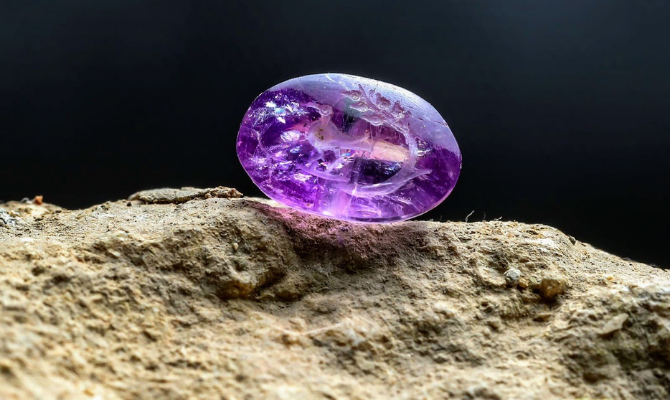Has a description of the fragrant persimmon plant been discovered for the first time on an archaeological find uncovered near the Temple Mount? During an archaeological dirt screening activity run by the City of David in the Emek Tzurim National Park, the participants were in for a surprise: among the spills of the archaeological dirt that came from the excavations conducted by the Antiquities Authority at the foot of the Western Wall, and which was filtered on the spot, a tiny oval, purple stone was uncovered that was used as a seal/stamp (“gama”) at the time of the Second Temple about 2000 years ago.
The stamp, made of Amethyst, a precious stone of purple and lilac shades bears a perforated channel across it, through which a metal wire was inserted to enable the stone to be worn as a ring. The length of the oval, stone seal is 10 mm, its width is 5 mm, and it is 7 mm thick. The seal was used to sign and certify documents and goods, and was a fashionable item that was worn decoratively as jewelry.
In a scientific article due to be published soon, the researchers Eli Shukrun, Prof. Shua Amorai-Strek and Malka Hershkovitz who studied the find, characterize the engraving on the seal. According to the researchers, engravings of two elements appear on the precious stone, adjacent to one another. The first element shows a bird, most likely a dove, and there is a long and rounded thick branch next to it, with five fruits on it. After examining the find, the researchers believe that the plant appearing on the stone is the fragrant persimmon plant, which is mentioned in the Bible, the Talmud and in other historical sources. The persimmon, which is not at all similar to the persimmon fruit of today, is described as an expensive plant, which was used to produce medicines, ointments and perfumes, and was even part of the incense that was burned in the temple.
“This is an important find because this is the first time that a stone seal has been discovered anywhere in the world with a description of the expensive and famous plant that we could only read about in historical sources and descriptions” says the archaeologist Eli Shukrun who conducted the excavation on behalf of the Antiquities Authority and the City of David at the foot of the Western Wall, where the find was discovered.
According to the researchers, “toward the end of the time of the Second Temple, the use of stone seals increased, and they became more common. However, in most of the seals that have been discovered with plant descriptions so far, it is common to find plants that were common in the Land of Israel at the time: vines, dates, and olives, which are among the seven species. When we came to examine the seal, we immediately noticed that the fruit that appears on it does not resemble any of the fruits that we have come across so far,” says Amorai-Strek. After a thorough examination of the find, the researchers hypothesized that it was a branch of fragrant persimmon.
According to Prof. Amorai-Strek, “the dove is a positive motif in the Hellenistic, Roman and Jewish world. It symbolizes wealth, happiness, goodness and success.” Prof. Amorai-Strek points out that there is an engraving on the seal to testify to the identity of the person who wore the ring. “If it is indeed the famous and expensive persimmon fruit, then it is likely that the owner of the seal was a Jew of means, since the production and trade that took place around the persimmon plant was controlled at that time by Jews who lived in the Dead Sea basin, where the fruit was grown. It is possible that the owner of the seal was a man who owned a plantation for growing persimmons”. According to archaeologist Eli Shukrun: “The find provides us with a glimpse into the daily life of the people who lived at the time of the Second Temple, the glory days of Jerusalem.”
Some Bible commentators identify the persimmon in the list of gifts given by the Queen of Sheba to King Solomon. In the writings of the historian Flavius Josephus, it is said that Marcus Anthonius gave a persimmon grove to his beloved Cleopatra as a gift.
The “Archaeological Experience” in the Emek Tzurim National Park, sponsored by the El Ir David Foundation and the Nature and National Parks Authority, is a large-scale archaeological project that offers an experience in archaeological activity to the general public, without the need for prior knowledge. The activity takes place with the close supervision of archaeologists, and as part of it, the participants become “archaeologists for a day” when they sift through dirt originating from the City of David excavations, and find treasures from the past. Among the findings discovered in the project so far are seal impressions from the First Temple period, coins from different periods in Jerusalem, arrowheads, jewelry, and more.




